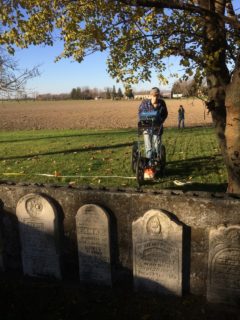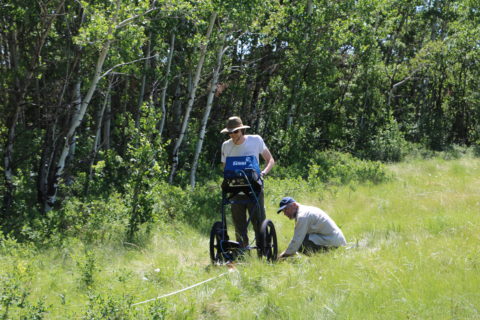Article begins
Many enslaved African Americans made their way to Southwestern Ontario, Canada, through the Underground Railroad network, in the hopes of gaining freedom from enslavement, only to be met with further prejudice upon their arrival. Despite the important role enslaved African-Americans played, there is little documentary information about them and their impact in shaping the history of Canada and the province of Ontario. However, a multi-component geophysical survey of the British American Institute (BAI) cemetery in Southwestern Ontario, recovered archaeological evidence of this crucial time.
The BAI was a training academy that served the inhabitants of the Dawn Settlement, one of several freedom-seeker communities in Southwest Ontario, and a terminus on the underground railroad. In recent times, the BAI cemetery has fallen into disrepair and the gravestones have been broken and rearranged into a central monument. Locating the unmarked graves and the site’s boundaries was the goal of our research. We used archaeological/ geophysical techniques (ground-penetrating radar, magnetic gradiometry and resistivity) and recorded local oral histories, as both a pathway for historical discovery and an instrument in the search for truth and justice for past and present peoples.

Ground-penetrating radar unmarked graves survey in progress at the BAI cemetery. Ontario Heritage Trust, November 2016.
This interest in uncovering unspoken stories brought me to the University of Toronto, where I studied archaeological science (specifically, bioarchaeology and remote sensing) for my undergraduate degree. At the Ontario Heritage Trust in Toronto, I had the fortune of meeting archaeologist Dena Doroszenko, who made me aware of a potential project that would allow me to use some of the techniques that I had learned as an undergraduate student to help an understudied and marginalized community. Originally, the project was only to locate the unmarked graves to aid the Ontario Heritage Trust in the management of the cemetery and protect it from future encroachment. However, once the project began, the site’s significance and real history soon became clear. The Underground Railroad is a striking example of human resistance and resilience in North America’s recent past.
Archival and historical evidence showed that the cemetery was linked to Josiah Henson, a former fugitive slave and inspiration for the book Uncle Tom’s Cabin, as well as other famous Ontario civil rights activists and events that are still part of the descendants’ identity. Combining oral history and geophysical techniques, we documented the destructive event that occurred at the British American Institute cemetery that resulted in the gravestones being broken, destroyed, and scattered. Furthermore, these stories from local descendants led us to refine our interpretations and re-analyze our data. After we had completed our survey, we coordinated with the Ontario Heritage Trust to hold a workshop, teaching these geophysical techniques and cemetery upkeep strategies to descendants, local residents, and cemetery conservation specialists. Through documenting the destruction of the BAI and training local groups in preservation, we hope that our efforts combat further destruction and neglect of historic cemeteries. Now, as I work on my master’s degree at the University of Alberta (hoping to soon publish the results of our survey), I have delved into anthropological theory. I realized that by incorporating diverse forms of evidence at the BAI cemetery, we had been doing what archaeologists have been doing for years, investigating place. The BAI school and its cemetery were cornerstones of this community and formed a unique part of their lives and experiences. It is now clear to me that at the confluence of art and science is where truly meaningful conclusions can be drawn.

Undergraduate thesis team at the survey site (BAI cemetery). Left to Right: William (Liam) Wadsworth, Katherine Patton (University of Toronto-Anthropology), and Carl-Georg (Charly) Bank (University of Toronto-Earth Sciences). Ontario Heritage Trust, May 2017.
For my master’s research, I am proposing to apply the same techniques used at the BAI to issues affecting Indigenous groups in Canada. Under the supervision of Kisha Supernant, and at the request of the community, I have used ground-penetrating radar to locate the graves of children at the Muskowekwan residential school. We have also been working closely with the Papaschase First Nation to locate a burial ground within Edmonton, Alberta as well as the Métis Nation of Alberta on investigations of various archaeological sites. This community-driven work falls in line with the calls to action set by Canada’s Truth and Reconciliation Commission.

Archaeological Remote Sensing survey of a Métis wintering site (Chimney Coulee, Saskatchewan). Kisha Supernant (University of Alberta). July 2018.
The emerging field of archaeological geophysics within anthropology has the potential to play a critical role in the search for truth and, if necessary, the pursuit of justice for past and present peoples around the world. I believe that continued work in this field will help to improve our relationship with our Indigenous communities (as well as other marginalized communities) and contribute to reconciliation and social change.
William “Liam” Wadsworth is a graduate student at the University of Alberta and a 2018 AD Student Membership Award Winner.
Cite as: Wadsworth, William. 2019. “Geophysics and Justice in Ontario.” Anthropology News website, February 27, 2019. DOI: 10.1111/AN.1102

